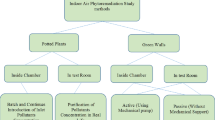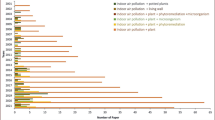Abstract
The quality of the indoor environment has become a major health consideration, since people spend 80–90 % of their time indoors. Research by a number of authors is reviewed here, demonstrating capacities of indoor plants to improve Indoor air quality. The studies show that plants can reduce indoor air pollutants by 75 % in different conditions. An evaluation of these studies done throughout the world clearly indicates that potted-plants can provide an efficient, self-regulating, low-cost, sustainable, bioremediation system for indoor air pollution, which can effectively compliment engineering measures to reduce indoor air pollution, and hence improve human wellbeing and productivity.
Access provided by Autonomous University of Puebla. Download chapter PDF
Similar content being viewed by others
Keywords
These keywords were added by machine and not by the authors. This process is experimental and the keywords may be updated as the learning algorithm improves.
Introduction
The quality of the indoor environment has become a major health consideration in the developed world, since urban-dwellers generally spend 80–90% of their time indoors [1–4]. Indoor air can often contain 5 to 7 times the contaminant concentrations of outdoor air [5–6]. The harmful effects of these mixtures have been recognized as components of ‘sick building syndrome’ or ‘building-related’ [7–8], with symptoms of headache, dizziness, nausea, sore eyes and throat, or loss of concentration. A number of studies have shown that potted-plants have a capacity to contribute to the improvement of indoor air quality, by reducing air-borne contaminants such as VOCs, nitrogen oxides and dust [9–12], as well as by aiding humidity, temperature and noise control [13]. It has also been shown that staff wellbeing (as measured by questionnaire surveys and interviews) and productivity (as reductions in sick-leave rates) is improved where indoor plants have been installed [14–15]. The aim of this paper is to provide a review of research on indoor plants to improve indoor air quality, to outline findings, and to present new data that further demonstrate the ability of potted-plants to remove indoor air pollutants and enhance IAQ.
Potted-plants Improve a Number of Aspects of IAQ
The studies undertaken to demonstrate the role of plants in controlling IAQ will be discussed in detail like Yoneyama et al. 2002 [16] reviewed absorption and metabolism of NO2 and NH3 in 220 species (sun- and shade-loving plants, the latter of which can be used indoors). In a UK homes with flueless gas appliances, Coward et al. 1996[12] found that houses with six or more potted-plants showed reductions of over one third in NO2 levels. In 1999, Lee and Sim [17] in a study in Korea showed that indoor plants absorb and metabolize SO2. In the USA, Lohr and Pearson-Mims 1996 [11] showed that indoor plants significantly reduce dust (particulate) levels. Costa and James 1999 [13] found that potted-plants also reduce indoor noise levels.
Plants as Decontaminants
Table 1 shows some plants which play an important role in removing indoor air pollutants, literature also reveals that staff wellbeing is improved with sick leave absences reduced over 60% [14–15]. An ability of foliage plants to absorb chemical compounds from the indoor air has been demonstrated in many studies. In the report of the National Aeronautics and Space Administration (NASA) Wolverton et al. 2005 [18] showed that low-light-requiring houseplants such as Bamboo palm, English ivy have the potential for improving indoor air quality by removing trace organic pollutants from the air in energy-efficient buildings. The removal of airborne toluene by means of the phyllosphere of Azalea indica augmented with a toluene-degrading enrichment culture of Pseudomonas putida TVA8 was studied by Kempeneer et al. 2004 [19]. This technique is promising and could be practical implemented in the field of indoor air pollution control.
Conclusions
The numerous studies reported here, and a number of different sources around the world, show conclusively that the potted-plant microcosm (PPM) can greatly improve IAQ by removing many major pollutants. Thus the PPM represents an adaptive, self-regulating, portable, flexible, low-cost, sustainable and beautiful biofiltration and bioremediation system for IAQ. This innovative technology can complement any engineering measures and can be used in any building.
Indoor potted-plants can remove air-borne contaminants such as volatile organic compounds (VOCs), CO, CO2, Benzene, formaldehyde, trichloroethylene, NOx over 300 of which have been identified in indoor air. This paper reviews the capacity of the potted-plant microcosm to contribute to cleaner indoor air, and lay the foundation for the development of the plant/substrate system as a complementary biofiltration system. To ensure sustainability of the urban environment, satisfying the ‘triple bottom line’ of environmental, social and economic considerations, it is expected that indoor plants will become standard technology – a vital building installation element, for improving IAQ.
References
G. Abbritti, and G. Muzi; Proceedings of Healthy Buildings, 95 an International Conference on Healthy Buildings in Mild Climate, University of Milano and International Centre for Pesticide Safety, Milano, Italy, (1995). pp. 185–195
M. Krzyanowski; Proceedings of Indoor Air 99, the 8th International Conference on Indoor Air Quality and Climate, Edinburgh, Scotland, (1999). pp. 230–232
D.O. Carpenter; Environ. Monit. Assess. 53 (1998) 245–258
American Lung Association; Air Quality, Australia (2001) pp. 10–13
A. Taneja, R. Saini and A. Masih; Ann. N.Y. Acod. Sci. 1140 (2008) 228–245
A. Kulshrestha, D.S. Bisth, J. Masih, D. Massey, S. Tiwari and A. Taneja; J. Atmos. Chem 62(2009) 121–138
D. Massey, J Masih, a. Kulshrestha, M. Habil, A. Taneja; Building and Environment, 44 (2009) 2037–2045
P. Carrer, D. Alcini, D. Cavallo, F. Visigalli, D. Bollini, and M. Maroni; Proceedings of Indoor Air 99, The 8th International Conference on Indoor Air Quality and Climate, Edinburgh, Scotland, August, (1999) 129–134
B.C. Wolverton, and J.D. Wolverton; J. Mississippi Acad. Sci. 38 (2) (1993) 11–15
M. Giese, U. Bauer-Doranth, C. Langebartels, and J.H. Sandermann; Plant Physiol. 104 (1994) 1301–1309
V.I. Lohr, and C.H. Pearson-Mims; Atmos. Environ. 30 (14) (1996) 2565–2568
M. Coward, D. Ross, S. Coward, S. Cayless, and G. Raw; Building Research Establishment Note N154/96, Watford, UK (1996)
P. Costa, R.W. James; In Proceedings of Indoor Air 99, Edinburgh, International Conference on Indoor Air Quality and Climate, Vol. 3, (1999) 234–239
J. Bergs; Proceedings of International Plants for People Symposium, Floriade, Amsterdam, NL, June, Flower Council of Holland, NL (2002)
T. Fjeld; In Proceedings of International Plants for People Symposium, Floriade, Amsterdam, NL, June, Flower Council of Holland, NL (2002)
T. Yoneyama; Prospects for Phytomonitoring and Phytoremediation, Springer, Tokyo, Japan (2002) 221–234
H. Lee and W.K. Sim; Contributions from International People-Plant Symposium”, Sydney (1999) 101–108
B.C. Walveston, A.Johnson and K.Bounds, Final Report, NASA Stennis Space Centre, MS.USA (1989)
L.D. Kempeneer, B. Sercu, W. Vanbrabant, V. Langenhove; Appl Microbial Biotechnol. 64 (2004) 284–288
Author information
Authors and Affiliations
Editor information
Rights and permissions
Copyright information
© 2012 Springer-Verlag Berlin Heidelberg
About this chapter
Cite this chapter
Pipal, A., Kumar, A., Jan, R., Taneja, A. (2012). Role of Plants in Removing Indoor Air Pollutants. In: Khemani, L., Srivastava, M., Srivastava, S. (eds) Chemistry of Phytopotentials: Health, Energy and Environmental Perspectives. Springer, Berlin, Heidelberg. https://doi.org/10.1007/978-3-642-23394-4_67
Download citation
DOI: https://doi.org/10.1007/978-3-642-23394-4_67
Publisher Name: Springer, Berlin, Heidelberg
Print ISBN: 978-3-642-23393-7
Online ISBN: 978-3-642-23394-4
eBook Packages: Earth and Environmental ScienceEarth and Environmental Science (R0)




